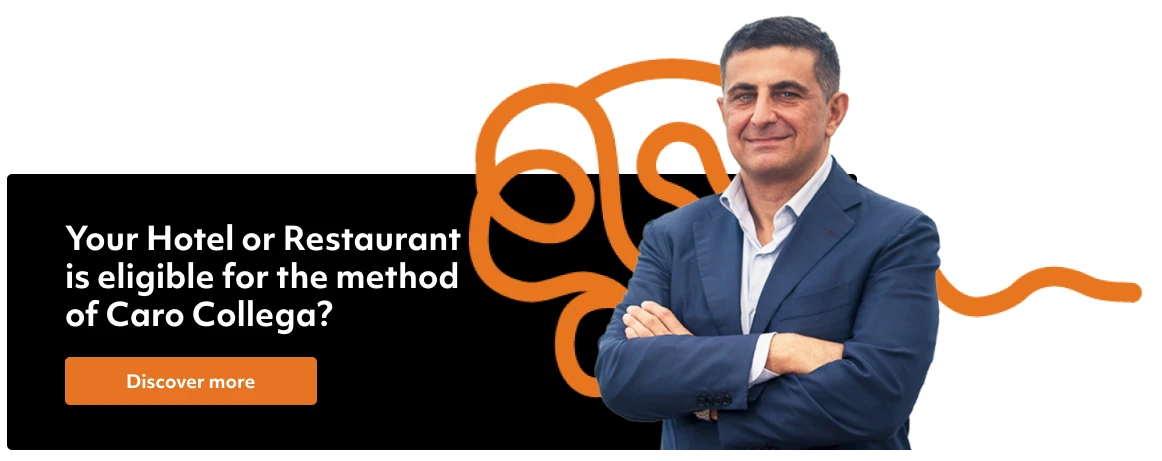70% is the number of searches that have a Restaurant as their subject according to Google. So much so that the Mountain View giant has thoughtfully added GPS and Restaurants to the name of its Google Maps APP.
If you are a Restaurateur and you are looking for new customers for your Restaurant you should definitely read this article because it can be metaphorically an artificial pond full of fish that are easier to bait.
I am Giancarlo De Leonardo former Restaurateur and Hotelier and founder of Caro Collega, a community of enlightened entrepreneurs with the goal of adding extra revenue directly proportional to integrated digital marketing activities.
I, too, for many years complained about having fewer and fewer customers, without putting in the proper effort to intercept them. Now I am very clear that I was fishing in the wrong pond (the one where the fish were over!) or rather that the lakes to fish in are others!
In this article
- The generic search for a Restaurant on Google and the specific search on Google Maps
- Google Ads and Local campaigns
- Tips for optimizing your Google My Business profile
- 3 Essential Local Campaigns for your Restaurant
- Conclusions
The generic search for a Restaurant on Google and the specific search on Google Maps
90% of people, depending on their nationality and digital familiarity, when they go on vacation to Italy or abroad, book their flight and hotel online before they leave using normal Google search.
Once they arrive at their destination, however, they decide day by day where to go to eat using Google Maps, the app found on every smartphone where you can find information, addresses and reviews of all the Restaurants of the World (at least the vast amount since in some countries such as Russia and China there are alternative search engines).
It is a behavior that unifies more than 70% of people, according to Google: picking up your smartphone and searching for information about where to go for lunch or dinner near where you are.
This is why “Restaurant nearby” accounts for 70% of Google Maps – GPS and Restaurants searches, which can be compared to the digital “Yellow Pages” providing a real list of restaurants, categorized and positioned according to the valuable criteria of Google’s latest algorithm, which is called BERT.
Restaurateurs and Restaurateurs everywhere, whether you become familiar with BERT or not will determine the great success or failure of your Restaurant.
With the understanding that for Google the first objective is to satisfy its users by providing the news most relevant to their needs, what I can tell you with extreme certainty is that Google maintains itself and makes money based on the advertising it sells.
Its interest coincides with that of your Restaurant: the more advertising (on Google Ads) intercepts interested customers, the more you will increase your advertising budget making the Mountain View giant’s cashier happy.
Within the Caro Collega community, at first all Restaurateurs were very skeptical as you are now, except that they are happy to invest more and more budget because as the investment increases they are aware that they will increase customers (pay per click, i.e., you pay to get attention of potential customers).
Do you have any idea what it might mean to get your restaurant’s advertisement in front of the eyes of potential customers who are in the area and are looking for a place to eat?
Furthermore I shared with you that the searches people do are mostly generic (nearby restaurant), so your Restaurant will be among Google’s recommended responses most of the times you place a paid ad, through Google Ads.
By activating ad campaigns, you can shine a spotlight on your business and intercept many new customers who would otherwise go to your competitors.
Google Ads and Local campaigns
Local campaigns on Google Ads are the best tools for the promotion and visibility of a Restaurant (or local business). These campaigns can be aimed at visiting the Restaurant, or initiating phone contact or collecting data from potential customers that we can contact later.
Local-type advertising campaigns are so called because they are used to reach an audience that is near your Restaurant. There are different types of campaigns you can use to promote visits or calls to your business: the Search, Performance max (formerly called “Local”) and Smart.
But why is it easy to get results with Local type ad campaigns?
Unlike Facebook and Instagram ad campaigns that are used to intercept latent audience demand, with Google Ads and Local-type campaigns you can intercept conscious demand; that is, the demand of an audience that is actively searching for a Restaurant that meets their needs. (For example, “seafood restaurant in Rome, all you can eat Japanese restaurant, restaurant with grill specialties, etc.).
Even on Google there are campaigns that can intercept latent demand, such as Facebook and Instagram: in fact, thanks to its Network and other types of campaigns such as Discovery, Display and those on YouTube, we can make our Restaurant’s ad appear even to those who are not making a specific search.
An essential step to activate Local campaigns on Google Ads is the optimization of the profile of the Restaurant on Google My Business.
If you want to be successful by activating Local-type campaigns for your Restaurant, you need to carry out prior profile optimization on Google (what used to be called Google My Business or GMB).
Having a good and optimized profile is useful to give visibility to the brand and to help the user when they are at the stage of choosing where to go; it can also serve to be found organically, that is, without the paid ads.
It is worth noting that the first 3 or 4 responses at the top of the Google page are normally the prerogative of Restaurants that invest on ads, then on local campaigns via Google Ads, while the later ones are reserved for Restaurants that curate the company’s profile on Google.
Tips for optimizing your Google My Business profile
Before you start investing time and economic resources in implementing Local type advertising campaigns on Google Ads, I want to share with you a best practice that all Restaurateurs within the Caro Collega Community follow, broken down into 5 simple steps within your reach:
- Make sure that the NAPs (name, address and phone) are up to date. Above all, check that the hours and closing days on Google accurately reflect reality and align with those on the website, TripAdvisor and Google.
- Add high-quality images: pictures can make all the difference in the presentation of your Restaurant. Upload high-quality photos that show the dishes you serve, the atmosphere in your restaurant, your staff, and anything else that can anticipate the experience you will reserve for patrons.
- Gather positive reviews. Customer reviews are a crucial element in your restaurant’s success. Encourage your satisfied customers to leave a review on your restaurant’s Google profile. Positive reviews will help build trust among potential customers and improve the reputation of your business.
- Use relevant keywords: when creating your Restaurant profile description on Google, use keywords that are relevant to your industry and specific. This will help Google better understand your offering and show your profile to users aligned with your offering.
- Enrich your restaurant profile with weekly posts, events and offers for your customers: Google likes to put more prominence on Restaurants that spend time creating useful content for its users. In addition, this information will be very useful since it allows Google to better understand what your business’s strengths are and present it to customers aligned with it.
3 Essential Local Campaigns for your Restaurant
Once you have provided Google My business profile optimization, you can start with 3 different types of advertising campaigns that will have the same goal, which is to generate extra revenue directly proportional to their performance and the budget invested.
1. Smart Campaigns (Smart). Smart campaigns are ideal for newbies or those without extensive experience in advertising. They were designed by Google specifically to simplify the process of creating, managing, and optimizing them. They use Artificial Intelligence and machine learning to automatically optimize campaign performance. This means that you will have almost zero control over all aspects related to the campaign. They can be used even if the restaurant does not have its own website or landing page.
2. Search Campaigns. This type of campaign is aimed at intercepting the user who is searching for a restaurant on Google. In this case, it is important that there is a landing page or website of the restaurant, which undoubtedly must be designed and implemented strategically for the purpose of conversion. Not surprisingly, the goal of your ad will be to land the user right on your website or related landing page.
In addition to activating this type of campaign, by linking the Restaurant’s Google profile to the Google Ads account, you will be able to exploit the location extension (asset) and show address and hours directly in our ad.
3. Max Performance Campaigns. For the past couple of years, Performance Max Campaigns have for all intents and purposes replaced the old “Local campaigns,” with the goal of presenting the Restaurant on all Google placements, including Maps.
With this type of campaign, we are going to cover both latent demand and conscious demand by letting Google’s algorithm identify the best performing combinations of images and text and reach the audience most interested in your offer.
It will then be the algorithm that decides the placement that will bring more results to our business, which we can measure in terms of conversions with requests for directions, reservations, and calls and also in terms of brand awareness (although the measurement is less intuitive).
Conclusions
For too many years I have either stood still like you, Caro Collega Restaurateur, who are reading this article, or I have been misguidedly advised by consultants who cheated me into thinking they could help me promote my business and instead were incapable.
Unfortunately, rejecting change is no longer an acceptable solution since we are selling out Restaurants and Hotels in our beloved Italy to the best foreign bidders. It is important that you understand that you can add extra revenue directly proportional to the digital marketing activities you decide to integrate.
The customers on Google are there and in abundant numbers, so from now on my advice is to work to intercept them.
Article written by Giancarlo De Leonardo, former Restaurateur and Hotelier, founder of Caro Collega

